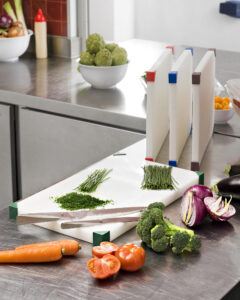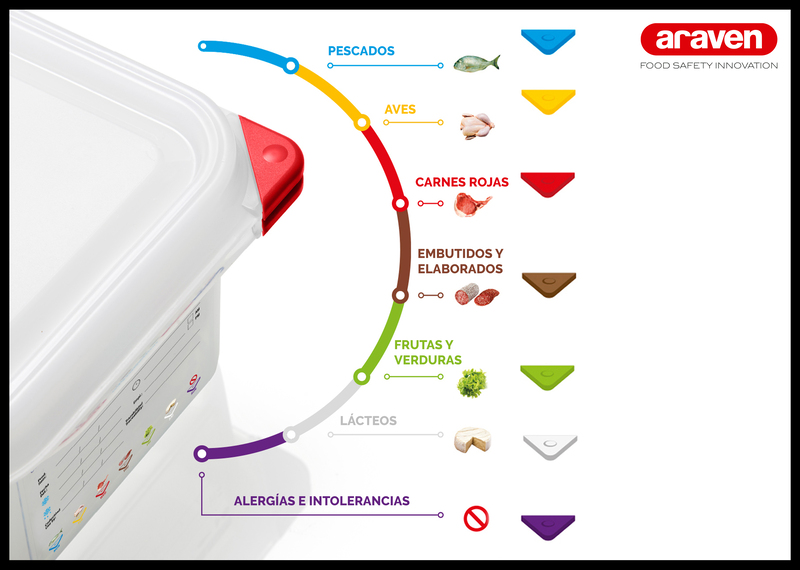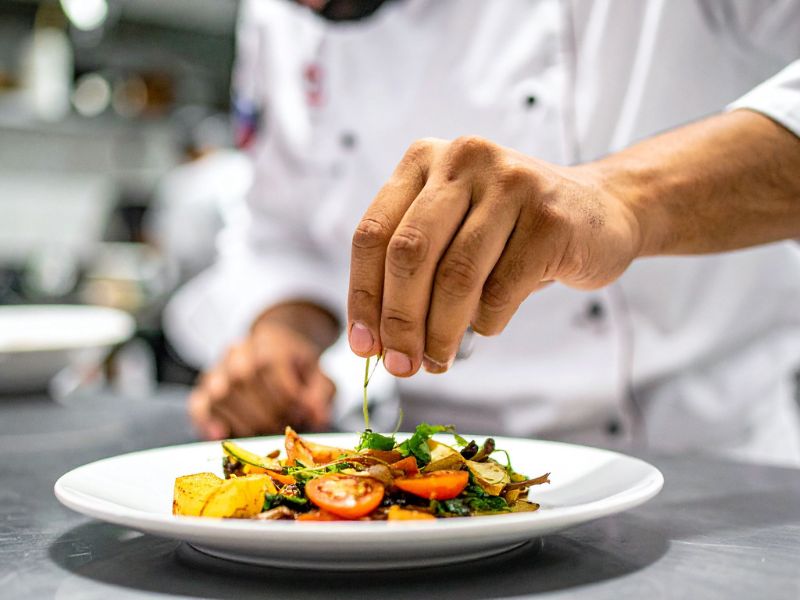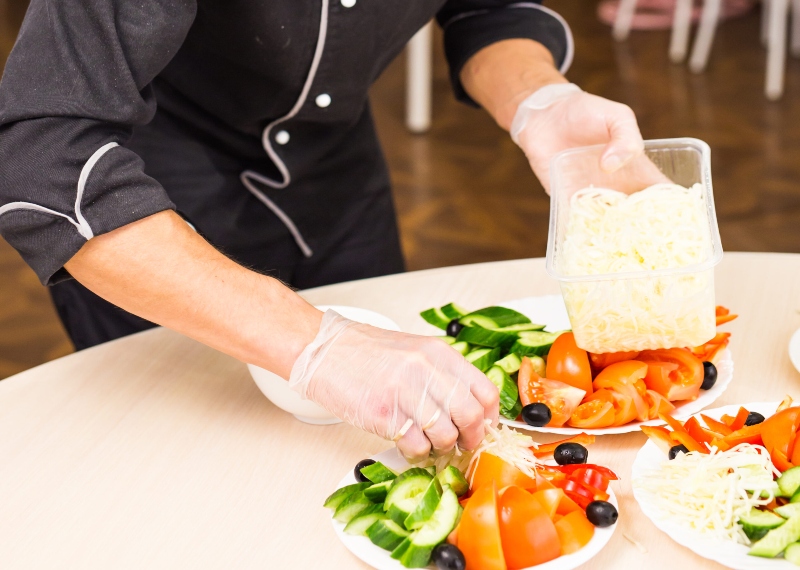Allergies, food poisoning, and even death. Cross-contamination in kitchens can lead to serious health risks. Preventing it is essential in any hospitality business. In this post, we’ll explain some key ways to avoid cross-contamination in your kitchen.
What is Cross-Contamination?
Cross-contamination is the process by which a food item becomes contaminated with harmful substances, leading to foodborne illnesses.
For at-risk groups, such as those with food allergies or intolerances, strict measures must be taken. It is essential to correctly identify the food in question and store it securely to protect it from allergens. In this regard, Araven offers a range of anti-allergen products, highlighted by their purple color. From cutting boards to sauce dispensers and airtight containers—discover our anti-allergen set!
In kitchens, there are many sources of cross-contamination. It’s not just spoiled food that’s a risk, but also the kitchen utensils themselves.
Health Risks of Food Cross-Contamination
Now that you know what cross-contamination is, it’s important to understand the health risks it can cause, especially when consuming raw foods. Cross-contamination in kitchens is responsible for:
- Food Allergies: Food allergies are no joke. In mild cases, the person may experience inflammation or hives, but in severe cases, the risk can be life-threatening.
- Food Poisoning: This is a type of foodborne illness caused by toxins produced by certain microorganisms. Common symptoms include vomiting, diarrhea, or abdominal pain.
- Food Infections: These are another type of illness caused by spoiled food. Bacteria, viruses, or parasites are often to blame.

Types of Cross-Contamination in Kitchens
There are two types of cross-contamination:
- Indirect Cross-Contamination: Work tools are the main cause of indirect cross-contamination. Knives, cutting boards, or even the hands of the person handling the food can spread contamination. In this case, cross-contamination is caused by an external agent, unrelated to the food itself.
- Direct Cross-Contamination: Never store raw and cooked foods, or different types of raw foods together, as this is a common cause of direct cross-contamination. It occurs when a clean food comes into contact with a contaminated one (usually raw foods). For example, when raw meat drips and its juices spill onto vegetables, the bacteria from the meat will transfer to the vegetables.
If you’re looking for a way to prevent food cross-contamination, Araven can help. Discover our color-coded cutting boards and airtight containers, designed specifically to separate different types of food.
How to Prevent Cross-Contamination
The importance of preventing cross-contamination in kitchens is clear. Every professional kitchen must take steps to eliminate this health threat. To help you protect the safety of your guests, here are some useful measures to follow:
Hygiene
When it comes to preventing cross-contamination, the first rule is hygiene. Washing your hands before cooking and after handling fresh foods is essential. Additionally, you should never use the same utensils or containers for preparing raw and cooked foods. If you’re using tools such as knives or cutting boards that have previously been in contact with raw food, it’s important to clean them with hot water and soap to avoid contamination.
Separating Foods
Proper food storage is essential to prevent food cross-contamination. Each type of food should be separated and stored in a specific area of the cold room. At Araven, we offer storage shelves designed for this purpose, ensuring that food is kept at the correct temperature and preventing contamination. Here’s how to store different types of food:
- Yogurt: Yogurt should be placed on the top shelf because, being pasteurized, it does not require low temperatures.
- Prepared Meals: If you have a container with a prepared dish that needs to be kept before reheating, it should be placed covered on the upper shelves. This prevents any food residue from contaminating already cooked food. However, if a prepared food falls onto a raw food, the contamination risk is lower since the raw food will be cooked, eliminating any bacteria.
- Fruits and Vegetables for Raw Consumption: Examples include lettuce, tomatoes, or carrots. These should be stored separately from other foods in the cold room, and if this isn’t possible, keep them covered and protected on the top shelves to avoid contamination from other foods.
- Fruits and Vegetables to Be Cooked: These should be stored on the lower shelves. In the event that they come into contact with other food residues, the subsequent cooking process will eliminate bacteria, reducing contamination risks.
- Meats and Fish: These should be stored on the middle shelves of the fridge. Foods that release more liquids should be placed below to prevent any leakage from contaminating other items.
Using Airtight Containers
Effective food management during storage is crucial to prevent food cross-contamination. Cooked foods should always be stored in airtight containers and placed on the upper shelves of refrigeration units. Otherwise, fresh items, especially meats and fish, could drip and contaminate ready-to-eat dishes.
To minimize risks, it’s essential to keep food securely sealed in clean containers. At Araven, we specialize in products designed to prevent cross-contamination. Our Gastronorm airtight containers, compliant with the EN 631.1 standard, are tailored to fit kitchen equipment and refrigeration units.
Using Different Cutting Boards
Color-coded cutting boards are essential in the hospitality industry. Blue, white, yellow, green, red, and brown boards help identify the type of food being prepared.
Additionally, purple cutting boards, like our non-slip model, are specifically designed for allergen-free meal preparation. For instance, they can help prevent cross-contamination from gluten when preparing dishes for sensitive customers.
Inspecting Food Quality Before Use
A fundamental rule in food safety: always check the condition of raw materials before cooking. This process should be thorough and systematic. At the slightest doubt about the quality of a product, it’s better to discard it than to risk cooking it.
Common Examples of Cross-Contamination
Wondering how cross-contamination in kitchens occurs? Here are some of the most common ways it can happen in a professional kitchen:
- Using the Same Cutting Board for Raw and Ready-to-Eat Foods: One of the most frequent examples of cross-contamination is cutting raw meat or fish and then slicing ready-to-eat items like fruit on the same board. To address this, we recommend using color-coded cutting boards, such as those offered by Araven, designed to separate food categories efficiently.
- Multi-Use Knives : Similarly, knives used for different types of food without proper cleaning in between can become a major source of cross-contamination. Always clean your tools thoroughly with hot water and soap after each use.
- Handling Mobile Phones in the Kitchen: Leave your phone outside the kitchen. Mobile phones are breeding grounds for microorganisms that can easily transfer to food during preparation.
- Washing Certain Foods: While washing fruits and vegetables is essential, avoid washing raw chicken or eggs. Cooking poultry eliminates potential pathogens, so washing it beforehand risks spreading bacteria around your workspace. Washing eggs can also strip their protective coating, encouraging bacteria to penetrate the shell.
- Dirty Kitchen Cloths: Kitchen cloths, sponges, and towels are often overlooked but must be replaced regularly to maintain hygiene. Dirty cloths are a common vector for bacteria.
- Unclean Refrigerators: If meat or fish drips in the fridge, clean it immediately. Routine cleaning is also crucial to ensure the refrigerator doesn’t become a hub for cross-contamination.




